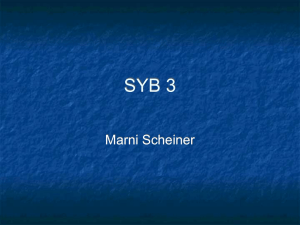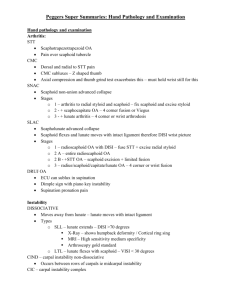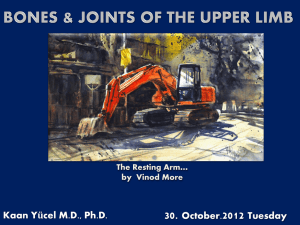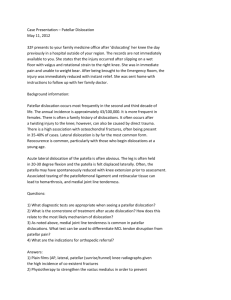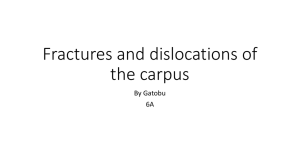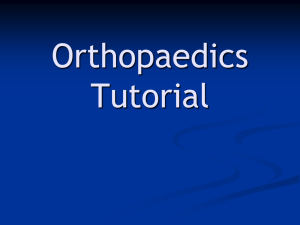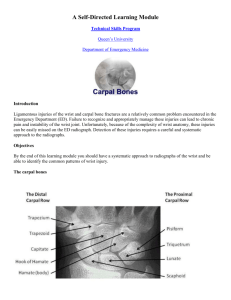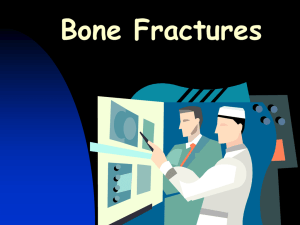Fractures and dislocations of the wrist - cox
advertisement
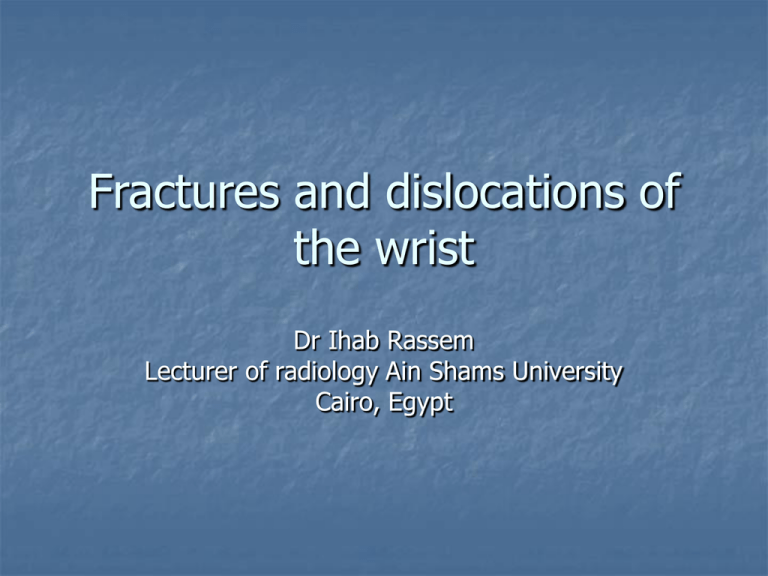
Fractures and dislocations of the wrist Dr Ihab Rassem Lecturer of radiology Ain Shams University Cairo, Egypt Radiographic views Dorsovolar (PA) Lateral Dorsovolar with ulnar deviation (scaphoid) Supinated oblique (pisiform, pisotriquetral joint) Pronated oblique (triquetral) Carpal tunnel (hook of hamate, pisiform, volar trapezium) Dorsovolar with ulnar deviation Supinated oblique Pronated oblique view Carpal Tunnel view Carpal bones fractures Scaphoid fracture Most common carpal bone to be fractured Age 15-30 Fall on outstretched arm Classification Distal pole and tubercle 5-10% Proximal pole 15-20% (nonunion & AVN) Waist 70-80% Scaphoid fracture PA PA with ulnar deviation Nonunited scaphoid fracture Scaphoid fracture seen in MRI AVN of scaphoid Fracture of triquetral Usually a subtle fracture Best seen in the lateral or pronated oblique view. Hamate fractures Usually arise due to direct blow to the volar aspect of the wrist Two types Fracture of the hook (hamulus) of hamate: Fracture of the body of hamate Hook of hamate is seen in dorsovolar view as a cortical ring. Absence, indistinctness, or sclerosis of this ring suggests hamulus fracture (eye sign) Carpal tunnel view is also helpful may may be difficult due to pain Fracture of pisiform bone Rare Results from fall on the outstretched hand or use of the hand as a hammer to strike an object May be isolated or co-exist with other bone fractures Best seen in supinated oblique or carpal tunnel view Fractrue of the capitate Results from fall on outstretched hands or form direct blow Usually associated with other carpal bone injuries particularly scaphoid fracture and perilunate dislocation Waist (neck) of capitate is the most common site PA view Tomogram Fracture of the lunate bone Usually result from fall on the dorsiflexed wrist or ecessive push on the heal of the hand Often associated with perilunate dislocation. More commonly occur as a pathologic fracture in the setting of Kienböck disease Kienböck Disease Avascular necrosis of the lunate bone, May be related to repeated trauma May be related to negative ulnar variance Classification Stage I: radiograph normal, transverse linear fracture on tomography Stage II: increased density with some flattening on the radial side Stage III: marked decrease in height of lunate with proximal migration of capitate Stage IV:radiocarpal joint osteoarthritis Stage I Stage II Stage III Stage IV Fracture of the trapezium Most commonly loading injury in the setting oa adducted thumb where the first metacarpal is driven into trapezium Associated with fracture of the 1st metacarpal base and subluxation or dislocation of 1st carpometacarpal joint Fracture trapezoid Rare fracture. Associated with dislocation of the 2nd metacarpal bone Carpal bones dislocations Normal anatomical relations Lateral view with wrist in neutral position: radius, lunate, capitate, 3rd metacarpal should be in the same line. Normal anatomical relations Dorsovolar view with wrist in neutral postion: 3 smooth unbroken arcs should be seen (Gilula arcs) Arc I: proximal articular surfaces of the scaphoid,lunate,& triquetrum Arc II: distal concavities of scaphoid, lunate, & triquetrum Arc III: proximal convexities of capitate & hamate Vulnerable zones theory Dislocations around the lunate can occur in two patterns. Lesser arc injury pattern: consist of pure ligamentous injuries leading to dislocations Greater arc injury pattern: consist of dislocation in addition to fracture of one or more of the bones around the lunate (scaphoid, trapezium, capitate, hamate, triquetrum). In cases of greater arc injury you mention the prefix trans- followed by the name of the fractured bone then the dislocation e.g. trans- scaphoid perilunate dislocation Greater arc =blue lesser arc = red Dislocations around the lunate Occur in sequential stages according to the severity of trauma Stage I: Scapholunate dissociation; rotatory subluxation of scaphoid Stage II: perilunate dislocation Stage III: midcarpal dislocation Stage IV: lunate dislocation Dislocations around the lunate Scapholunate dissociation Results from injury of the scapholunate ligament Radiographicaly diagnosed by Terry Thomas sign due to widening of the space between the scaphoid and lunate more than 2 mm Terry Thomas sign Rotatory subluxation of scaphoid Related condition to scapholunate dissocaition where there is in addition rotation of the scaphoid along its long axis Radiographically diagnosed by signet ring sign: volar tilt of the scaphoid makes it appear foreshortened with its tuberosity seen end on giving a cortical ring. Radiographs in dorsovolar view should be in the neutral position or with ulnar tilt for this sign to be reliable one Neutral position signet ring sign Radial tilt Normal scaphoid Perilunate dislocation On lateral view: Dorsal or volar dislocation of the capitate. Lunate remains in articulation with the radius although there may be some degree of tilt On dorsovolar view Crowdening of the proximal and distal carpal rows Break in arcs II and III at the site of the capitate Lunate dislocation On lateral view Axis of lunate is titled away from the articular surface of radius (spilled tea cup sign) Capitate remains in normal alignment with radius and 3rd metacarpal On dorsovolar view Disruption of arc II while arc III remains intact DISI VISI Thank you
